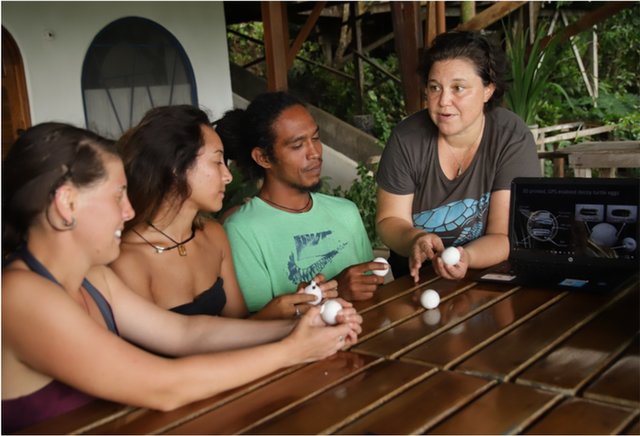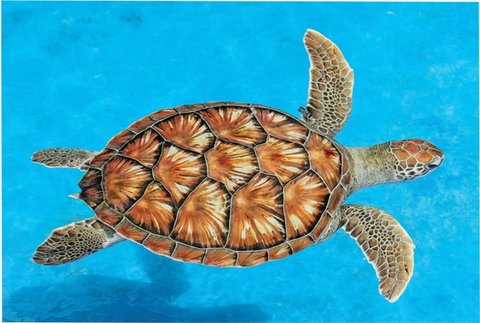FindingaPartner
PasoPacíficoteamedupwithwildlifebiologistHelenPheasey.Pheaseywaswillingtoplantsomedecoy eggs.
Shehadthreegoals.First,sheneededtoseeifthetechnologyintheeggswouldworkinthefield.Second,sheneededtoseeifthedesignoftheeggscouldtrickpoachers.Andthird,sheneededtomakesurethatthefakeeggsdidnotdisturbtherealeggs’ health.
Sofar,thenewshasbeengood.Thehealthyeggsarenotbotheredbythefakeeggs.Thepoachershavebeenfooled.Andthetrackingworks.Pheaseywasabletotracksomedecoystotheirdestinations.Thesystemisn’tperfect.Limitedcellnetworkscouldlimittheirabilitytotracktheeggs.But,it’sagood start!

APasoPacificoturtlerangercollectsturtleeggsforsafekeeping nearby.

KimWilliams-Guillenexplainstovolunteershowthefakeseaturtleeggs work.
WhatComesNext
Usingmorefakeeggsisthenextstep.Withmoredata,itwillbeeasiertomakeamaptoshowwheretheeggsaretraded.Thelocationswillhelptheteambetterunderstandthedemandforturtle eggs.
ExpertsbelievemostofthestoleneggsmaketheirwaytoElSalvadororGuatemala.Thereisalsoaconcernthatseaturtleeggsarebeingshippedoverseas.Ifthisistrue,itcouldmeannewmarketsfortheeggs.Andatradethatwouldbehardertocombat.Still,theinformationgatheredbytheteamcouldhelppolicecapture poachers.
Thedatacouldalsobeusedforconservationprojects,suchasbeachpatrolstomonitorthe nests.
Williams-Guilléndoesn’tthinkherfakeeggswillsolvetheproblemofturtleeggpoaching.Butshedoesthinkitcouldbeapowerfultool.Combinedwithotherconservationefforts,itcouldhelpensurethatseaturtlesaresafeforthe future.

Protectingseaturtlesalsoprotectstheenvironment.Healthyoceansneedsea turtles.
Seaturtlesareanimportantpartofahealthymarineecosystem.YetNicaragua,whosebeacheshavelongbeencrucialnestinggrounds,hasseenasharpdeclineinsea turtles.

green seaturtle
Length:100centimeters (3.2 feet)
Weight:180kilograms (397 pounds)
Presence:CaribbeanCoast,Pacific Coast
Status: Endangered
ManygreenturtlesarecaughtinNicaraguafor food.
Seaturtlesareanimportantpartofahealthymarineecosystem.YetNicaragua,whosebeacheshavelongbeencrucialnestinggrounds,hasseenasharpdeclineinsea turtles.

hawksbillseaturtle
Length: upto94centimeters (3 feet)
Weight: 80kilograms (176 pounds)
Presence: CaribbeanCoast,Pacific Coast
Status: Critically Endangered
Theshellofthehawksbillturtleisoftenusedtomake souvenirs.
Seaturtlesareanimportantpartofahealthymarineecosystem.YetNicaragua,whosebeacheshavelongbeencrucialnestinggrounds,hasseenasharpdeclineinsea turtles.

leatherbackseaturtle
Length:150centimeters (5 feet)
Weight:upto700kilograms
(1,543 pounds)
Presence:CaribbeanCoast,Pacific Coast
Status:Critically Endangered
Theleatherbackturtleisthelargestseaturtlelivingon Earth.
Seaturtlesareanimportantpartofahealthymarineecosystem.YetNicaragua,whosebeacheshavelongbeencrucialnestinggrounds,hasseenasharpdeclineinsea turtles.

oliveridleyseaturtle
Length:upto74centimeters(2.4 feet)
Weight:45kilograms (100 pounds)
Presence:Pacific Coast
Status:Vulnerable
Oliveridleyturtlesarethemostabundantseaturtle,yettheyarestill endangered.